You’ve just bought your dream travel enduro and the next motorbike trip is already planned. Now all that’s missing are aluminium cases, or plastic cases, or side bags – what’s best?
Page Contents (click line to jump the text)
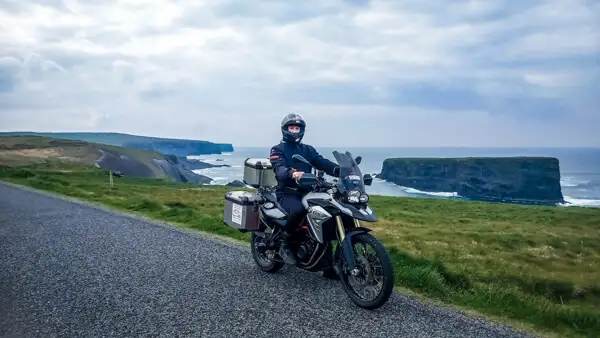
Intro
Through many years of motorbike travel with various motorbikes and through our own motorbike rental company in Ireland (meanwhile closed), I have had the good fortune to be able to test the various systems intensively several times and over many thousands of kilometres.
This is not about a specific luggage model, but we will take a look at the advantages and disadvantages of aluminium panniers, plastic panniers and soft side bags and find decision-making criteria that will help you find the best luggage system for your motorbike trip.
The most important criteria for choosing a motorbike case are the intended use, the packing volume and the price.
For light off-road use, aluminium cases or soft luggage are a good choice. For difficult off-road riding, soft-sided cases are recommended because of their lighter weight and because there is less risk of injury in the event of a fall.
For pure road use, plastic cases usually offer good value for money. The packing volume should be adapted to the use: If you mainly do day trips, 15-20 litres of volume per bag/case are sufficient; for long trips, 30-40 litres of volume per bag/case are recommended.
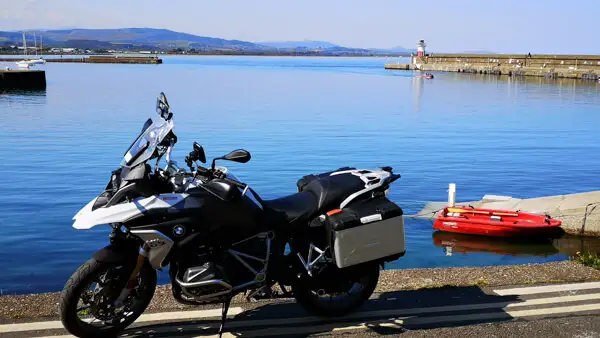
14 decision-making criteria for choosing the right motorbike cases
1) Versatility in use
2) Stability
3) Repairability
4) Risk of injury in the event of a fall
5) Durability / ageing / wear and tear
6) Weight and portability
7) Suitability for pillion riders
8) Lockability
9) Loadability
10) Waterproofness
11) Behaviour at high speeds / motorway
12) Pack volume
13) Prices of panniers or side bags with carrier system
14) Taste and personal preferences
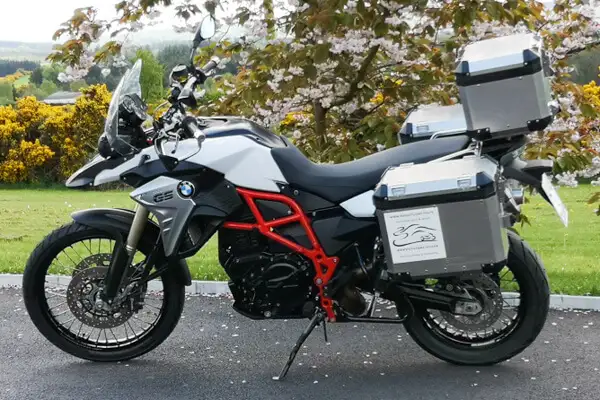
Let’s take a detailed look at the individual criteria:
1) Versatility in use
The most important question is: Do you only ride on the road or also off-road? Do you ride light gravel roads from time to time, or do you also do technically demanding off-road rides?
Also important: Do you mainly do day rides, or many long trips?
Do you always ride alone, or with a passenger? Are you tall and strong, or rather short and slim? Do you ride a lot at high speeds on the motorway? We will look at these questions and possible answers in more detail in the following points.
2) Stability
When riding off-road, the risk of falling is higher. It is usually not a question of whether you fall off-road, but rather when, how often and how badly. Most of the time you are far away from the next road where a tow truck could come along, so you want to be as sure as possible that you can bring your motorbike with luggage back to the tarmac reasonably intact.
Here, aluminium cases, which are usually built for this purpose, have a clear advantage over road-oriented plastic cases, which will break quickly. There are also plastic cases for off-roaders, which are somewhere in between.
But aluminium cases can also break off: the weak points are usually the fastenings on the carrier and the closure of the lid. If the case comes loose from the carrier, you can fix it temporarily with packing straps, but this is not always easy because of the smooth shape.
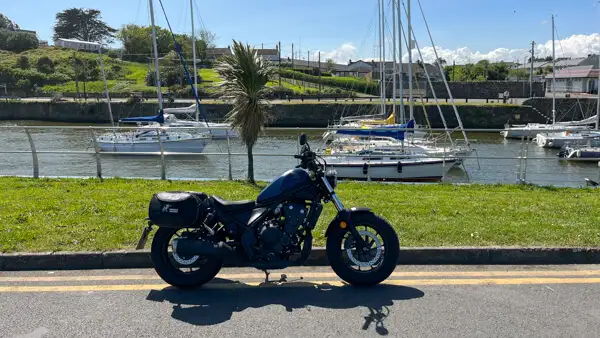
Recently, more and more excellently crafted side pannier systems for off-roaders have come onto the market, which are made of strong Cordura and are very stable when dropped. If a flap tears off, you can usually make do with rope or packing straps and continue riding.
For the pure road rider, the risk of falling is lower and the stability of the panniers less decisive. If something should happen, help is usually readily available on asphalt. Lightweight side bags and road plastic panniers are good alternatives here.
3) Repairability
For off-road long-distance travellers, this has to do with stability. Somewhere in the middle of nowhere you can temporarily sew a soft bag yourself.
A motorbike repair shop or a metalworker will be able to fix the torn-off bracket of the aluminium case, but you may not have any riveting pliers with you.
For broken plastic cases, help often comes too late – you will have to buy a new case.
4) Risk of injury in case of a fall
This topic is also relevant for off-road riders: Most of the time you will ride standing up in difficult sections, but sometimes, e.g. in muddy or sandy gullies, it can make sense to ride sitting up and walking with your feet.
Anyone who has ever had their calf caught under the edge of the aluminium case knows how painful and dangerous this can be (I speak from personal experience). In this case, slightly smaller, higher soft bags can be the better solution. Especially if they have a rounder shape and are mounted somewhat flexibly.
For road riders, this issue is less relevant.
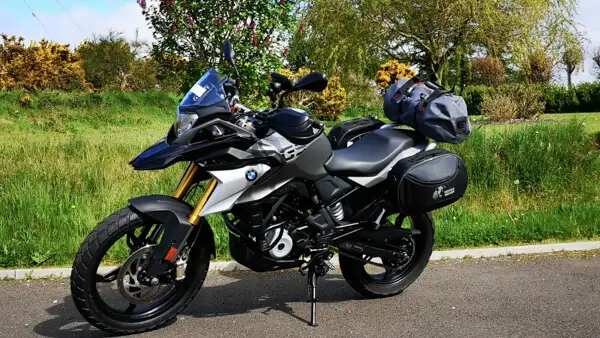
5) Durability / ageing / wear and tear
How long do you want to use your suitcases? Depending on the answer, the initially high price can be put into perspective.
Aluminium suitcases are not susceptible to weathering and in principle will last forever. You may have to replace a rusty lock at some point, but that’s about it. However, they do form ugly dark-grey aluminium abrasion when they rub against each other. So you should definitely use inner pockets and will have to live with a rustic outer “patina”. But you can probably still use them on your next motorbike and the one after that.
Plastic ages in sunlight and becomes brittle over time. Plastic is also more likely to break in cold temperatures. Nevertheless, road riders’ plastic cases will probably last as long as the motorbike itself.
Soft luggage is similar in appearance to plastic cases if well made and of good materials. The plastic fabric will also eventually become brittle and glue or seams may come loose, but you will be able to use good bags for many years.

6) Weight and portability
This is not really an issue for tall and strong road riders. If you use inner bags, you will hardly carry your panniers around and the increased overall weight of the ride is not so bad in this case.
Smaller and lighter built riders should pay more attention to the wipe, because for them manoeuvring the bike is difficult enough as it is. Plastic cases are often lighter than aluminium cases and soft luggage is even lighter!
This is even more the case off-road: The motorbike industry propagates that 270kg “touring enduros” with panniers are great for off-road riding and shows fancy videos where professional rally riders demonstrate this quite impressively.
But for us “normal riders” the high weight increases the effort, fatigue and risk of injury considerably! For light gravel roads and big strong riders, aluminium panniers might still be a good choice, but at the latest when the terrain becomes difficult, lighter soft panniers (on a light motorbike!) definitely make more sense.
7) Pillion suitability
You would think that renowned motorbike manufacturers would pay attention to whether their aluminium panniers still leave enough room for the average-sized pillion passenger, but we have an example in our fleet where the manufacturer obviously didn’t think about the pillion passenger at all. The space between the original aluminium panniers does not fit the pillion at all!
Anyone who rides with a pillion even occasionally should check the fit before buying. In our experience, the manufacturer’s own plastic cases are often better suited for pillion use.
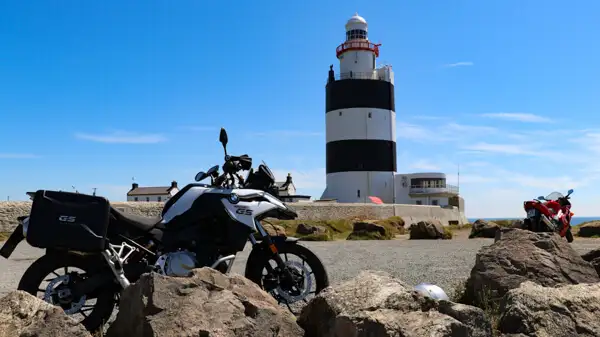
8) Lockability
If you only do day trips with light luggage, you may leave your rain suit and water bottle unlocked on the motorbike. For holiday and long-distance travellers, however, it is usually an advantage to be able to lock the luggage.
Aluminium cases and plastic cases usually have locks, soft luggage not necessarily.
Sometimes you can lock the zip ends of soft cases with a small case lock, but that’s easy to get around with a knife. Better protection is provided by an additional steel luggage net, which you can buy as an accessory.
Alternatively, when you get off, take all your valuables with you in a small bag and you can live with that in case someone actually steals your underwear….
By the way, even with aluminium or plastic suitcases I would always take the valuables with me, because the suitcases can also be “cracked” quickly with a long screwdriver or small bolt cutter. But they do offer a little more protection against theft.
9) Ease of loading
This is where aluminium cases score points – because they are usually top-loaders. It is very practical to lift the lid briefly to put something in or take something out without everything falling out.
Plastic road cases are mostly side-loaders. You open the lid and the entire contents spill out onto the street. But at least you can get to everything. Interior pockets are a remedy for chaos.
Soft luggage can be very clear and easy to access, or very fiddly. Most of the time you have to rummage through the contents of the bag to find everything. Trying it out at your leisure before buying will help you make a decision.
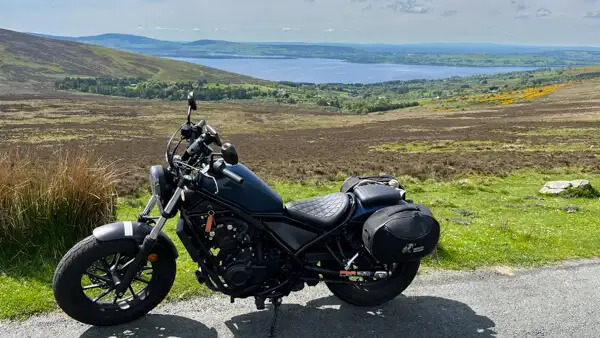
10) Waterproofness
Suitcases are usually rainproof, as long as they are not damaged by a fall, then this can change. In any case, it makes sense to use inner pockets.
If you take your aluminium suitcases off-road when crossing a river, it is better to have waterproof inner pockets in the suitcases.
Side pockets are either designed to be waterproof with a roll closure, or there are waterproof covers or inner pockets with roll closure, which you can also buy very cheaply in the accessories section. Here, too, think about damage due to a fall.
11) Behaviour at high speeds / on the motorway
Some cases or bags are hardly noticeable at 160 km/h, others cause the vehicle to swing quickly or whistle terribly in the wind. Read the online reviews of the pannier systems, then you will learn a lot. Forums can also be helpful.
Plastic panniers that are well integrated into the vehicle are often better than aluminium panniers that stick out far and also have less wind resistance, which means less fuel consumption on fast journeys.

12) Packing volume
If you mostly do day rides and only occasionally go on tour without a pillion, you don’t need to buy heavy or bulky cases. There are great soft luggage side panniers, with and without carriers. They usually only have a volume of 15-20 litres per side, but on tour you can add a tank bag or a luggage roll. On the other hand, the narrower bike is more fun to ride in everyday life, easier to get on and off and lighter in weight. The carrier systems for side bags are usually small and do not look as obtrusive on the rear vehicle as large tube systems.
For all frequent and long-distance travellers, however, it may be rather 30-40 litres volume per side.
13) Prices of the cases or side bags with carrier system
Prices vary greatly according to quality and design. A set of robust aluminium panniers with a high-quality carrier can quickly cost 1200-1500€.
Plastic panniers from motorbike manufacturers usually do not require an extra carrier, at most a small mounting plate on the passenger footrest. Their price is around 600-800€.
Lightweight road luggage without a carrier is available from 100-200€. With carriers and/or high-quality off-road side panniers, the price can quickly reach 500€ or more.
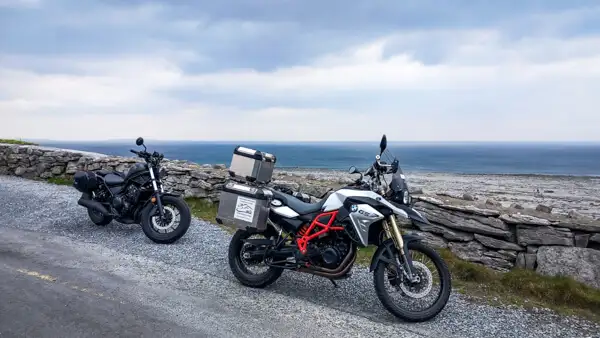
14) Taste and personal preferences
The choice of luggage system is of course also strongly dependent on the personal preferences or taste of the rider. Who wants ugly, clunky luggage on a beautiful motorbike when there are more stylish alternatives? For that, you might as well dig a little deeper into your wallet, right?
Decision matrix
In the following table, we weight the criteria for each use in order to arrive at a decision that is as comprehensible as possible.
A good match with the criterion is rated with 3 points, medium with 2 and low match with 1 point.
| Decision matrix | Plastic panniers | Aluminium Paniers | Soft bags |
| 1) Versatility | 2 | 3 | 3 |
| 2) Stability | 1 | 3 | 2 |
| 3) Repairability | 1 | 2 | 3 |
| 4) Risk of injury in the event of a fall | 1 | 1 | 3 |
| 5) Durability | 2 | 3 | 2 |
| 6) Weight and Portability | 2 | 1 | 3 |
| 7) Suitability for pillion riders | 3 | 1 | 2 |
| 8) Lockability | 2 | 3 | 1 |
| 9) Loadability | 2 | 3 | 1 |
| 10) Waterproofness (with inner liner) | 3 | 3 | 3 |
| 11) Behaviour at high speeds / motorway | 3 | 2 | 2 |
| 12) Packing volume | 3 | 3 | 2 |
| 13) (Low) Price incl. frame/carrier | 2 | 1 | 3 |
| 14) Taste / personal preference | 3 | 3 | 3 |
| Sum of points: | 30 | 32 | 33 |
Conclusion
Point 14 has not been evaluated or has the same score for every variant, because this is very subjective. You can obviously decide to your preferences.
If you only ride on the road, you can ignore the off-road relevant points in the table above and you will arrive at a different point total – then suitcases will probably be more interesting than bags.Nothingvery smallmediumlargevery large
You may find other criteria that are important to you when choosing motorbike luggage, but in any case, this has given you a good starting point for your buying decision. Build your own table with your own criteria and evaluate them according to your opinion and you will come to a good decision.
Whatever you decide, have fun on your upcoming motorbike trips!
More interesting articles for you
WHICH ARE THE BEST ADVENTURE MOTORCYCLE TYRES FOR IRELAND
PACKING AND EQUIPMENT TIPS FOR MOTORBIKE TOURING IN IRELAND
THE BEST MOTORBIKE FOR THE IRELAND TOUR – OR OTHER TRAVELS
PREPARING FOR A MOTORBIKE TRIP IN IRELAND – ROUTE SELECTION AND NAVIGATION
Photo credits cover photo: Motorbike at the northern coast of Donegal, photo by Ulrich Knüppel-Gertberg (www.irland-insider.de, www.ireland-insider.com)